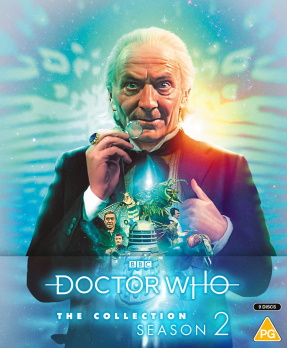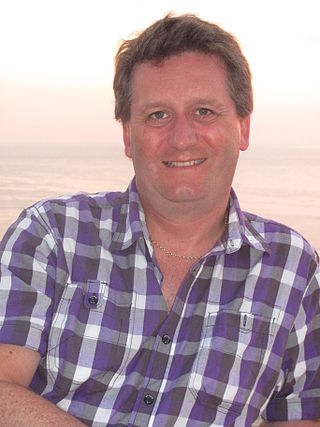
Doctor Who is a British science fiction television series broadcast by the BBC since 1963. The series, created by Sydney Newman, C. E. Webber and Donald Wilson, depicts the adventures of an extraterrestrial being called the Doctor, part of a humanoid species called Time Lords. The Doctor travels in the universe and in time using a time travelling spaceship called the TARDIS, which externally appears as a British police box. While travelling, the Doctor works to save lives and liberate oppressed peoples by combating foes. The Doctor often travels with companions.

The Daleks are a fictional extraterrestrial race of extremely xenophobic mutants principally portrayed in the British science fiction television programme Doctor Who. They were conceived by writer Terry Nation and first appeared in the 1963 Doctor Who serial The Daleks, in casings designed by Raymond Cusick.

Sydney Cecil Newman was a Canadian film and television producer, who played a pioneering role in British television drama from the late 1950s to the late 1960s. After his return to Canada in 1970, Newman was appointed acting director of the Broadcast Programs Branch for the Canadian Radio and Television Commission (CRTC) and then head of the National Film Board of Canada (NFB). He also occupied senior positions at the Canadian Film Development Corporation and Canadian Broadcasting Corporation, and acted as an advisor to the Secretary of State.

An Unearthly Child is the first serial of the British science fiction television series Doctor Who. It was first broadcast on BBC TV in four weekly parts from 23 November to 14 December 1963. Scripted by Australian writer Anthony Coburn, the serial introduces William Hartnell as the First Doctor and his original companions: Carole Ann Ford as the Doctor's granddaughter, Susan Foreman, with Jacqueline Hill and William Russell as school teachers Barbara Wright and Ian Chesterton. The first episode deals with Ian and Barbara's discovery of the Doctor and his time-space ship, the TARDIS, in a junkyard in contemporary London. The remaining episodes are set amid a power struggle between warring Stone Age factions who have lost the secret of making fire.

The Daleks is the second serial in the British science fiction television series Doctor Who, which was first broadcast on BBC TV in seven weekly parts from 21 December 1963 to 1 February 1964. Written by Terry Nation and directed by Christopher Barry and Richard Martin, this story marks the first appearance of the show's most popular villains, the Daleks, and the recurring Skaro people, the Thals. In the serial, the First Doctor, his granddaughter Susan Foreman, and her teachers Ian Chesterton and Barbara Wright land in an alien jungle and are captured by the Daleks, a race of mutated creatures who survive off the radiation that remains in the atmosphere after a nuclear war with their enemies. As the group attempt to escape the Daleks, they discover more about the planet and the ensuing war, and attempt to broker a peace.
Day of the Daleks is the first serial of the ninth season of the British science fiction television series Doctor Who, which was first broadcast in four weekly parts from 1 to 22 January 1972. It was the first of four Third Doctor serials to feature the Daleks, which returned to the series for the first time since The Evil of the Daleks (1967).

"Mission to the Unknown" is the second serial of the third season of the British science fiction television series Doctor Who. Written by Terry Nation and directed by Derek Martinus, the single episode was broadcast on BBC1 on 9 October 1965. The only standalone regular episode of the show's original run, it serves as an introduction to the 12-part story The Daleks' Master Plan. It is notable for the complete absence of the regular cast and the TARDIS; it is the only serial in the show's history not to feature the Doctor at all. The story focuses on Space Security Agent Marc Cory and his attempts to warn Earth of the Daleks' plan to take over the Solar System.

The Daleks' Master Plan is the mostly missing fourth serial of the third season in the British science fiction television series Doctor Who, which originally aired in twelve weekly parts from 13 November 1965 to 29 January 1966. This twelve-part serial is the longest with a single director and production code (The Trial of a Time Lord was longer but was made in three production blocks, with separate codes, and with four separate story lines each with their own authors and working titles).

Planet of Giants is the first serial of the second season in the British science fiction television series Doctor Who. Written by Louis Marks and directed by Mervyn Pinfield and Douglas Camfield, the serial was first broadcast on BBC1 in three weekly parts from 31 October to 14 November 1964. In the serial, the First Doctor, his granddaughter Susan Foreman, and her teachers Ian Chesterton and Barbara Wright are shrunk to the size of an inch after the Doctor's time machine the TARDIS arrives in contemporary England.
Revelation of the Daleks is the sixth and final serial of the 22nd season in the British science fiction television series Doctor Who, which was first broadcast in two weekly parts on 23 and 30 March 1985. This was the final serial to be broadcast in 45-minute episodes; this format would return 20 years later when the series resumed in 2005. Revelation of the Daleks is the only time the Sixth Doctor encountered the Daleks in a television story.

The Myth Makers is the third serial of the third season of the British science fiction television series Doctor Who. Written by Donald Cotton and directed by Michael Leeston-Smith, the serial was broadcast on BBC1 in four weekly parts from 16 October to 6 November 1965. In the serial, based on Homer's Iliad, the First Doctor and his travelling companions Vicki and Steven land in Troy during the Trojan War. The Doctor is captured by the Greeks and forced to formulate a plan for taking the city, while Steven and Vicki are captured by the Trojans and forced to devise a means of banishing the Greeks; the latter duo meet Katarina, who becomes a companion by the serial's end.
Death to the Daleks is the third serial of the 11th season of the British science fiction television series Doctor Who, which was first broadcast in four weekly parts on BBC1 from 23 February to 16 March 1974.

The First Doctor is the original incarnation of the Doctor, the protagonist of the British science fiction television series Doctor Who. He was portrayed by actor William Hartnell in the first three series from 1963 to 1966 and the tenth anniversary story The Three Doctors from 1972 to 1973. The character would occasionally appear in the series after Hartnell's death, most prominently as portrayed by Richard Hurndall in the 1983 multi-doctor special The Five Doctors, and as portrayed by David Bradley in the 2017 Twelfth Doctor episodes "The Doctor Falls" and "Twice Upon a Time" and in the 2022 Thirteenth Doctor episode "The Power of the Doctor", the latter previously having portrayed Hartnell himself in the 2013 biopic An Adventure in Space and Time.

Fans of the long-running British science fiction television series Doctor Who are referred to as Whovians, or collectively as the Doctor Who fandom.
Zerinza was the first, and for many years the only regular Australian Doctor Who fanzine. It ran continuously from 1976 to 1986 when edited and published by Antony Howe, for the Australasian Doctor Who Fan Club (ADWFC), reaching issue number 35. Since then, there have been several isolated issues on special topics, sporadically up to mid-2000, edited by others but most with some degree of input from Howe. Reviews, articles and interviews in this "high-quality" fanzine were authoritative and are cited in serious studies of Doctor Who and some have been republished in books of interviews. The fanzine was for a decade the journal for the ADWFC and it played a key role in creating and expanding Doctor Who fandom in Australia, reaching about 1,000 subscribers by the mid-1980s. It was partly founded to rally fans against the Australian Broadcasting Commission's decision to cease purchasing the Doctor Who series, launching a "Save Doctor Who Campaign" with the first issue, it contained relating news items thereafter. Zerinza, and Howe, were often credited by fans with the subsequent decision by the ABC to resume and increase screening the series.

The twenty-fifth season of British science fiction television series Doctor Who began on 5 October 1988. It comprised four separate serials, beginning with Remembrance of the Daleks and ending with The Greatest Show in the Galaxy. To mark the 25th anniversary season, producer John Nathan-Turner brought back the Daleks and the Cybermen. The American New Jersey Network also made a special behind-the-scenes documentary called The Making of Doctor Who, which followed the production of the 25th anniversary story Silver Nemesis. Andrew Cartmel script edited the series.

The second season of British science fiction television series Doctor Who was originally broadcast on BBC1 between 1964 and 1965. The season began on 31 October 1964 with Planet of Giants and ended with The Time Meddler on 24 July 1965. Like the first season, production was overseen by the BBC's first female producer Verity Lambert. Story editor David Whitaker continued to handle the scripts and stories during early production, handing over to Dennis Spooner as the season began to air; Spooner subsequently left his role by the season's end, and was replaced by Donald Tosh for its final serial. By the season's end, Lambert was the only remaining production member from the team responsible for creating the series.

The first season of British science fiction television programme Doctor Who was originally broadcast on BBC TV between 1963 and 1964. The series began on 23 November 1963 with An Unearthly Child and ended with The Reign of Terror on 12 September 1964. The show was created by BBC Television head of drama Sydney Newman to fill the Saturday evening timeslot and appeal to both the younger and older audiences of the neighbouring programmes. Formatting of the programme was handled by Newman, head of serials Donald Wilson, writer C. E. Webber, and producer Rex Tucker. Production was overseen by the BBC's first female producer Verity Lambert and story editor David Whitaker, both of whom handled the scripts and stories.

David J. Howe is a British writer, journalist, publisher, and media historian.














